Introduction
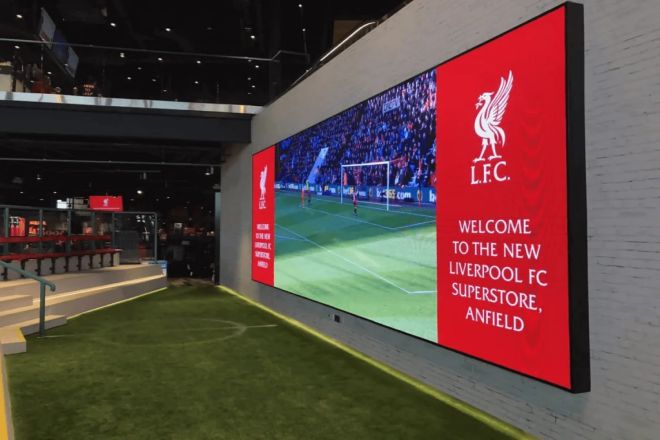
Are you dazzled and confused when embarking on the journey of purchasing an LED display? Faced with many brands and models, how can you quickly lock in the “perfect screen” that can both show your personality and efficiently convey information?
Don’t worry; this article is your compass! We will cut straight to the core and reveal to you the 8 key parameters that you must pay attention to when purchasing an LED display. These parameters are not only a yardstick for measuring the performance and quality of the display but also the key to maximizing your return on investment.
Follow our steps, you will easily grasp the key points of purchase, making every visual display the focus, and every information transmission accurate and powerful. Now, let’s start this journey of selecting LED displays together!
1. Resolution and pixel pitch of LED display
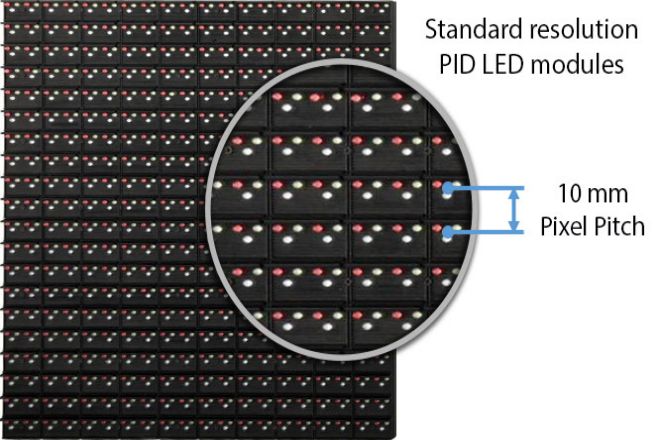
When exploring the factors of purchasing LED displays in-depth, resolution and pixel pitch are undoubtedly the core parameters that determine its visual effects and applicable scenarios. They are not only related to the clarity and fineness of the image but also directly affect the audience’s viewing experience.
1). Resolution: the cornerstone of delicate images
Resolution, the mystery behind this number, directly determines the degree of fineness of the image that the LED display can display. Simply put, the higher the resolution, the more pixels on the screen, the more finely the image can be divided and presented, resulting in a clearer and more delicate picture effect.
For application scenarios that pursue high-quality displays, such as high-end conference rooms, cinema screenings, or art exhibitions, high-resolution LED displays are undoubtedly the first choice. It can make every frame of the picture delicate and detailed, making the audience feel as if they are in the real scene.
2). Pixel pitch (Pitch): “adjuster” of viewing distance
The pixel pitch is a physical quantity that measures the distance between the pixels of the LED display.
This parameter is crucial to determine the optimal viewing distance. Generally speaking, the smaller the pixel pitch, the denser the pixels on the screen, which can support a closer viewing distance without obvious graininess.
On the contrary, a display with a larger pixel pitch is more suitable for long-distance viewing to ensure the coherence and comfort of the overall picture.
In different application scenarios, the recommended pixel pitch range will also be different. For example, in the field of outdoor advertising, due to the long viewing distance and complex ambient light, a display with a larger pixel pitch is usually selected to ensure the visibility and stability of the picture.
In the field of indoor high-definition displays, such as live sports events and concerts, in order to meet the audience’s high requirements for picture quality, they tend to choose a display with a smaller pixel pitch to achieve a more delicate picture performance.
Therefore, when purchasing an LED display, we need to reasonably choose a combination of resolution and pixel pitch according to the specific application scenario and viewing needs. Only in this way can we ensure that the display can perform at its best and have the best effect in actual use.
2. Brightness and contrast of LED display
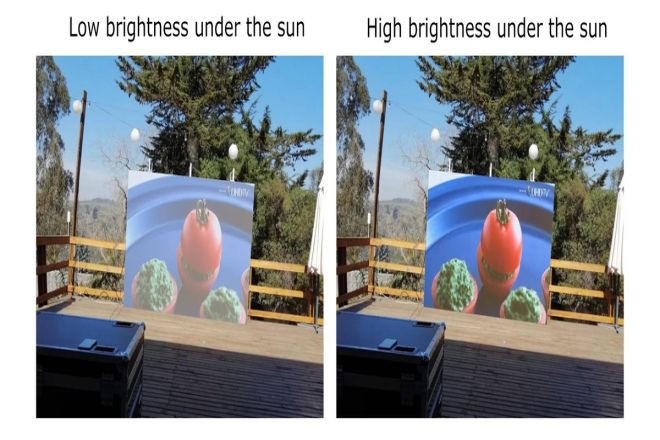
In the performance indicators of LED displays, brightness and contrast are two crucial factors that together determine the visual expression of the display in different environments and the viewing experience of the audience.
1). Brightness: The mystery of nits
Brightness is a physical quantity that measures the intensity of light emitted by LED display screens. Its unit is often expressed in nits. The higher the nit value, the stronger the light emitted by the display screen, and the picture can still be clearly seen in a strong light environment.
For outdoor display screens, since they need to resist the interference of strong light sources such as direct sunlight, they usually need to have a higher brightness value to ensure the readability and attractiveness of the picture. Generally speaking, the brightness of outdoor LED screens can reach thousands to tens of thousands of nits.
In contrast, indoor screens have relatively low brightness requirements due to the relatively soft ambient light. Excessive brightness will not only waste energy but may also cause discomfort in the audience’s vision.
Therefore, indoor screens usually choose appropriate brightness values according to specific usage scenarios and lighting conditions to achieve the best visual effect and comfort.
2). Contrast: The key to layering and details
Contrast refers to the brightness difference between the brightest and darkest parts of the display. High contrast can enhance the layering of the image, making the bright parts of the picture brighter and the dark parts darker so as to more vividly show the outline, texture, and details of the object.
This improvement in visual effects is of great significance to improving the audience’s viewing experience.
Especially when watching high-definition videos, game screens, or complex images, high contrast can make it easier for the human eye to distinguish the details and layer changes in the picture, bringing a more immersive visual enjoyment.
Therefore, when purchasing LED screens, in addition to paying attention to their brightness values, you also need to pay attention to the performance of contrast. Generally speaking, screens with high contrast will be better in image quality and visual effects.
At the same time, by reasonably adjusting the brightness and contrast settings of the display, the display effect can be further optimized to meet the needs and preferences of different audiences.
3. The viewing angle range of the LED display
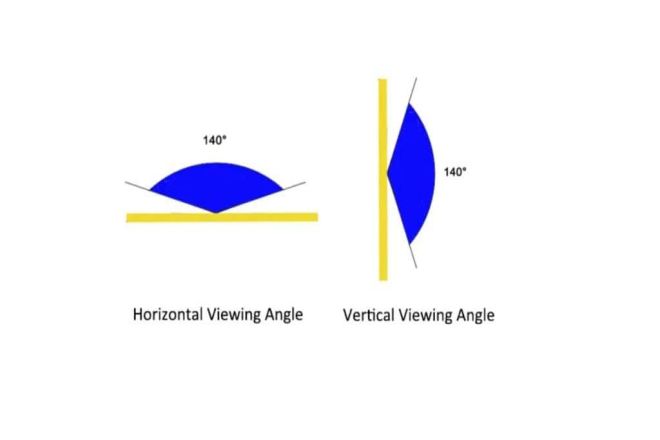
The viewing angle range of the LED display, like the size of its “field of view,” determines whether you can see it clearly and comfortably in any direction. This “field of view” has two directions: horizontal and vertical.
1). What are horizontal and vertical viewing angles?
- Horizontal viewing angle:
Imagine you are standing in front of the screen. The maximum angle you can see the screen on the left and right sides is the horizontal viewing angle. The wider this angle, the clearer you can see the screen from the side.
- Vertical viewing angle:
Similarly, when you stand in front of the screen and look up or down, the maximum angle you can see the screen is the vertical viewing angle. This angle also affects your viewing experience, especially when there is a height difference when you are standing or sitting.
2). Why is a wide viewing angle important?
A wide-view LED display is like having an extra-large “eye.” No matter which direction you look at it from, it can “see” you and let you see a clear and bright picture.
This is especially important for occasions where many people watch together, such as conference rooms, exhibitions, or outdoor advertising.
3). Requirements for viewing angle range in different places
3.1). Conference room:
- Requirement:
Because there may be many people in the conference room, sitting in different positions, the LED display needs to have a wider viewing angle range so that everyone can clearly see the content on the screen.
- Recommendation:
For medium or large conference rooms, the horizontal and vertical viewing angles should preferably reach about 160° and 140°, respectively, so that people sitting in the corner can also see clearly.
3.2). Outdoor advertising screen:
- Requirement:
The outdoor advertising screen will attract the attention of many people, and people may stand at different distances and angles to see it. Therefore, its viewing angle range should be as large as possible.
- Recommendation:
The horizontal viewing angle of the outdoor advertising screen should preferably reach 170° or wider, and the vertical viewing angle should also be kept at a high level so as to ensure that clear advertising content can be seen from all angles.
In short, the viewing angle range of the LED display is very important for the viewing experience. When selecting and using it, the appropriate viewing angle range should be determined according to the actual scene and the needs of the audience.
4. Refresh rate and grayscale of LED display screens
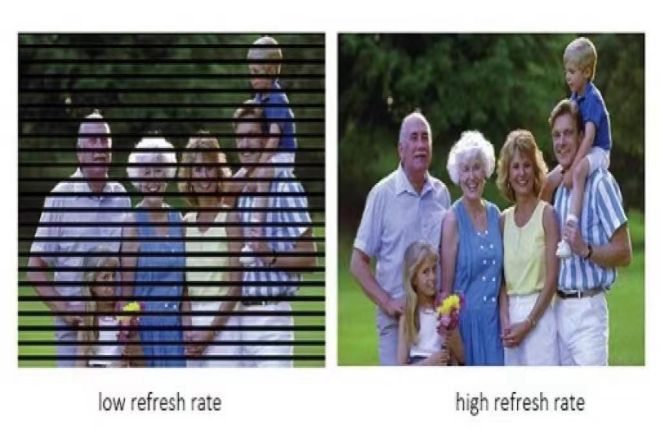
When we talk about LED display screens, there are two particularly important “little secrets” that affect how they look: refresh rate and grayscale.
1). Refresh rate: make the picture move more smoothly
The refresh rate is like the number of times the screen “blinks” per second. The more times, the smoother the picture. Imagine if you watch an action movie and the screen “blinks” many times per second; then those fast-moving pictures will not be blurry and look real.
This is the benefit of a high refresh rate, which makes dynamic things look more natural and not dragging. Moreover, your eyes will not be so tired after watching for a long time.
Especially when watching sports games or playing e-sports games, a high refresh rate is simply a magic weapon so that you will not miss any wonderful moments.
2). Grayscale: The delicate master of color transition
The grayscale level is like the “steps” of color. The more steps, the more delicate the color transition. Imagine if you have a box of colored pencils; the more colors you have, the more delicate and realistic you can draw.
This is the reason for grayscale, which determines how many different brightness levels the display can display. A high grayscale display is like a pencil case with many colors, which can draw richer colors and more delicate pictures.
Whether it is dark or bright, it can be seen clearly, and the color transition is very natural. In commercial presentations or TV broadcasts, such high grayscale displays are particularly popular because they can present more realistic and attractive pictures.
So, next time you look at an LED display, you might as well pay attention to its refresh rate and grayscale level. These two “little secrets” are the key to making the picture vivid and delicate!
5. Color performance of LED display
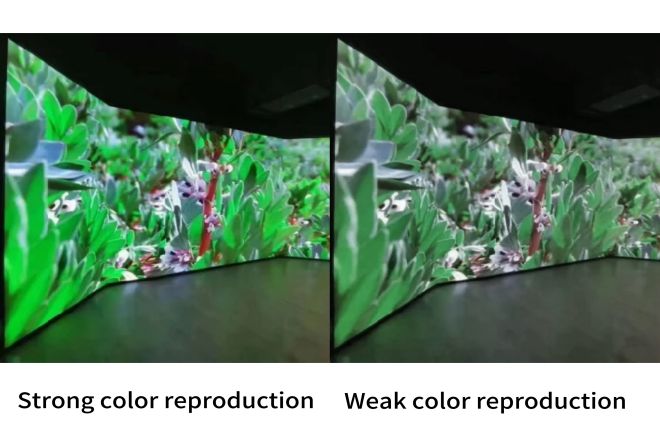
The color performance of LED display is one of the important criteria for measuring the quality of its visual effects. When discussing this topic, we have to mention the two key factors of color gamut range and true color display technology, which work together on the color reproduction, saturation and accuracy of LED display.
1). Color gamut range: a vast world of colors
The color gamut range is like a painter’s palette. The more colors on the palette, the more diverse and realistic colors the painter can mix. sRGB is like a basic version of the palette, which contains most of the colors seen in daily life.
But if you want to draw brighter and more vivid colors, such as the green leaves in nature and the orange-red of the sunset, then the “advanced” color palette, such as DCI-P3, is more suitable for you. It provides a wider color space, making your picture closer to the colors of the real world.
2). True color display technology: the magic addition of color
With the color palette, you still need some skills to make the colors more colorful. This is where true color display technology comes in.
HDR technology is like adding a super spotlight to your picture, making the bright places brighter and the dark places darker while retaining more details. In this way, the picture has a stronger sense of three-dimensionality and layering, and the colors are more vivid and full.
And quantum dot technology is like adding a small magic filter to each color, making the color purer and more accurate as if you are standing directly in front of the landscape painting.
6. Protection level and durability of LED display
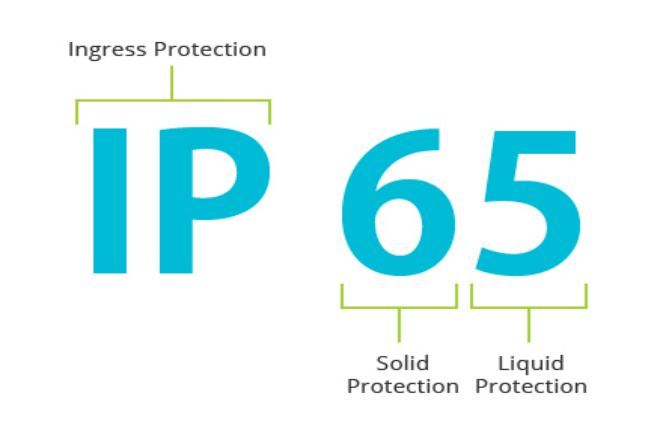
1). The meaning of IP protection level
IP protection level, full name Ingress Protection Rating, is a standard drafted by the International Electrotechnical Commission (IEC) to evaluate the dust and water resistance of electronic equipment. It consists of two numbers.
The first number represents the dustproof level, ranging from 0 to 6. The larger the number, the stronger the dustproof ability; the second number represents the waterproof level, ranging from 0 to 8 (some say 9, but it is less common in actual applications).
The larger the number, the stronger the waterproof ability.
For LED display screens, the level of IP protection directly determines its applicability and durability in different environments.
For example, IP65-rated display screens have high dustproof and waterproof capabilities, can resist the invasion of most dust and jet water, and are suitable for outdoor environments such as squares and highways.
IP67 or IP68-rated display screens have stronger waterproof and dustproof capabilities and can even be used underwater for a period of time, making them suitable for more severe environments.
2). Contribution of material selection to display screen durability
- Cabinet material:
The cabinet is an important part of the LED display screen, and its material directly affects the overall durability of the display screen. Common cabinet materials include aluminum alloy, stainless steel, etc.
Aluminum alloy cabinets have the characteristics of light weight, high strength, and corrosion resistance, which are suitable for most outdoor environments. Stainless steel cabinets have higher corrosion resistance and wind pressure resistance, and are suitable for extremely harsh environments.
In addition to the material itself, the sealing of the box is also key. A good sealing design can prevent moisture and dust from entering the interior of the display screen, protecting the internal circuit and LED chip from damage.
- LED chip quality:
LED chip is the core component of the display screen, and its quality directly affects the display effect and life of the display screen. High-quality LED chips have higher luminous efficiency, lower power consumption and longer service life.
When choosing LED chips, you need to consider factors such as their brand, model, and packaging method. Well-known brands and models usually have better performance and stability, while the appropriate packaging method can improve the chip’s impact and vibration resistance.
7. Features and key points of vertically wall-mounted LED display

1). The “brain” of the LED display screen-control system
Imagine that the LED display screen is like a super large electronic canvas, and the control system is its “brain”. How important is this “brain”?
Fast response: It is responsible for quickly transmitting what you want to show (such as videos, pictures, and text) to the display screen so that it can be displayed in time. If the “brain” reacts slowly, the display screen will freeze or delay, and it will not look smooth.
Stable and not sick: The control system must be particularly stable and cannot be “sick” (failed) at any time. Once it is “sick,” the display screen may go black or display the wrong content, which is troublesome.
Easy to operate: It is best to be easy to operate so that people can use it at a glance. Just like smartphones, everyone likes a simple and intuitive operating interface that can be used without reading the manual.
2). The “appetite” of LED display screen-compatibility
Another feature of the LED display screen is that it has a good “appetite” and can “eat” (receive and display) everything. The “eat” here means that it can receive signals from different devices.
Not picky: Whether it is a computer, mobile phone, or camera, as long as the signal is right, the LED display screen can receive and display it. Just like we are not picky about food, balanced nutrition can make us healthier.
Intelligent adaptation: Moreover, it is very smart. For example, if you connect a new device, it will automatically identify the type and settings of the device, and then adjust itself to adapt to the device to ensure that the content can be displayed perfectly.
Strong scalability: With the development of technology, new devices, and signal sources will continue to appear. A good LED display control system should be able to keep up with the pace of the times, support new devices and signal sources, and keep its “appetite” always good.
8. After-sales service and technical support of LED display

1). Things about after-sales service
- How long is the warranty period:
Just like checking the warranty period when buying things, you should also ask clearly how long the warranty is when buying an LED display. Generally speaking, most products have a warranty period of two years. But different manufacturers may be different.
You must ask clearly before buying so that there will be no problem when the warranty period has expired.
- How fast is the repair:
If the display is broken, how long will it take you to repair it? This depends on the supplier’s repair response time.
A good supplier will send someone to repair it as soon as possible, so that you don’t have to wait too long. Therefore, before buying, you can ask them how long it will take to repair it, so that you have a bottom line in your mind.
- Is technical support reliable:
If you encounter problems during use, who can you ask for help? This is the role of technical support.
A good supplier will have professional technicians who can help you solve the problem through telephone, Internet, or door-to-door service. You can learn about their technical support capabilities before buying.
2). Choose a brand and look at word of mouth
- Is the brand famous:
I like to choose big brands when buying things because big brands are usually more reliable. The same is true for buying LED display screens. Choose brands with high reputations and good reputations. Their products and services are generally not too bad.
- Is the service system complete?
The key to whether the after-sales service is good or not is the service system. Good suppliers will have a complete after-sales service network, and you can find them no matter where you are.
In addition, they will provide regular maintenance services to help you check the condition of the equipment and prevent failures.
Conclusion
In summary, buying LED display screens is a complex process that requires comprehensive consideration of many factors. From resolution and pixel pitch to color performance and control system to after-sales service and technical support, each parameter is directly related to the performance, effect, and long-term satisfaction of the display screen.
Therefore, we recommend that consumers do sufficient market research before purchasing, clarify their own needs, and make detailed comparisons and evaluations based on the above key parameters. Only in this way can we ensure that the selected LED display screen can not only meet the current display needs but also maintain competitiveness and sustainability in future development.
Finally, if you want to know more about LED display screens, please get in touch with us.
